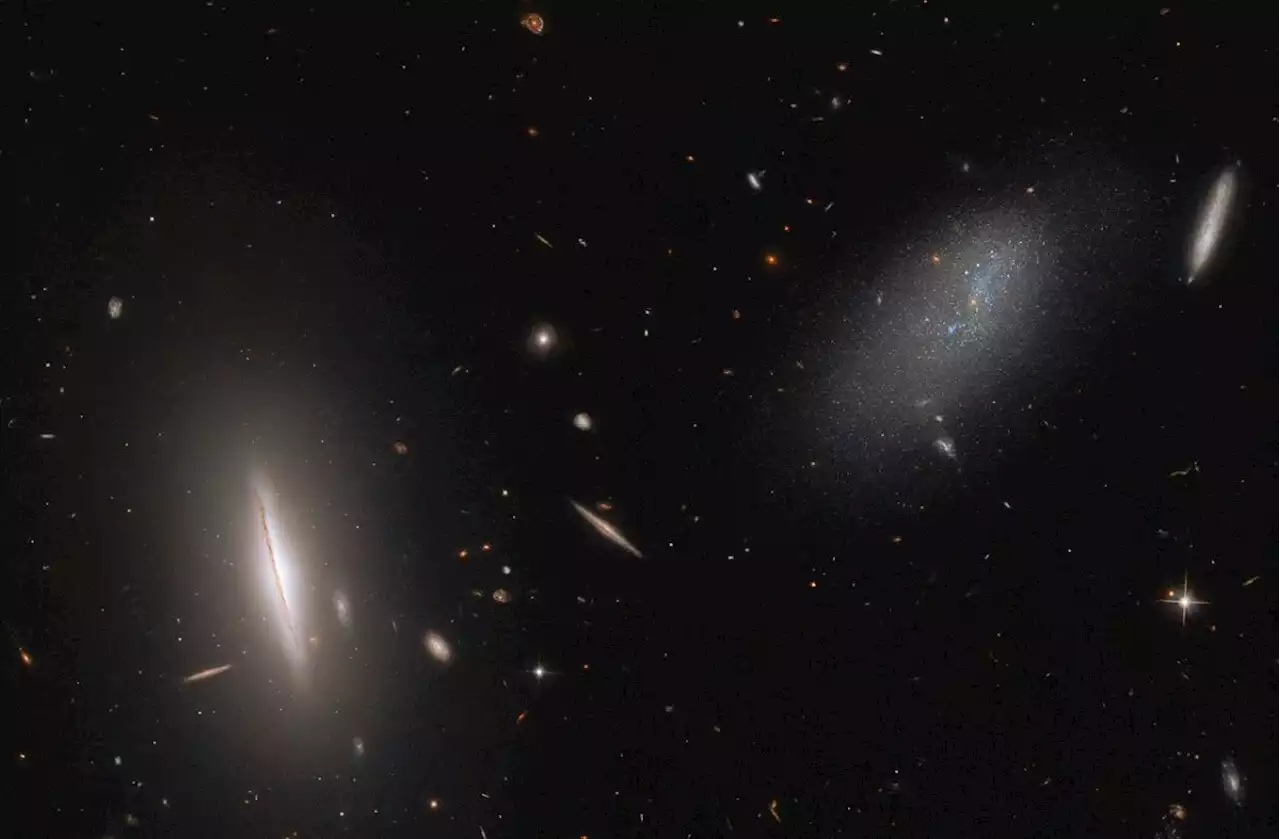Researchers can now see the influence of young stars on galaxy formation.
In the MIRI observations of NGC 1365, clumps of dust and gas in the interstellar medium have absorbed the light from forming stars and emitted it back out in the infrared, lighting up an intricate network of cavernous bubbles and filamentary shells created by young stars releasing energy into the galaxy's spiral arms. At the center of NGC 7496, a barred spiral galaxy, is an active galactic nucleus .
PHANGS researchers are thrilled with the new images, which reveal previously unseen details, such as"glowing cavities of dust and huge cavernous bubbles of gas" within the galaxy's arms. "Areas which are completely dark in Hubble imaging light up in exquisite detail in these new infrared images, allowing us to study how the dust in the interstellar medium has absorbed the light from forming stars and emitted it back out in the infrared, illuminating an intricate network of gas and dust," said PHANGS team member Karin Sandstrom of the University of California, San Diego.
The researchers will continue to study star formation and inventory these newly revealed structures in the interstellar medium across the 19 galaxies they're studying.
United States Latest News, United States Headlines
Similar News:You can also read news stories similar to this one that we have collected from other news sources.
 James Webb Space Telescope uncovers new details in Pandora's ClusterAstronomers have revealed the latest deep-field image from the NASA/ESA/CSA James Webb Space Telescope, featuring never-before-seen details in a region of space known as Pandora's Cluster (Abell 2744). Webb's view displays three clusters of galaxies—already massive—coming together to form a megacluster.
James Webb Space Telescope uncovers new details in Pandora's ClusterAstronomers have revealed the latest deep-field image from the NASA/ESA/CSA James Webb Space Telescope, featuring never-before-seen details in a region of space known as Pandora's Cluster (Abell 2744). Webb's view displays three clusters of galaxies—already massive—coming together to form a megacluster.
Read more »
 James Webb Space Telescope opens Pandora's Cluster in stunning image with help from Einstein (video)Robert Lea is a science journalist in the U.K. whose articles have been published in Physics World, New Scientist, Astronomy Magazine, All About Space, Newsweek and ZME Science. He also writes about science communication for Elsevier and the European Journal of Physics. Rob holds a bachelor of science degree in physics and astronomy from the U.K.’s Open University. Follow him on Twitter sciencef1rst.
James Webb Space Telescope opens Pandora's Cluster in stunning image with help from Einstein (video)Robert Lea is a science journalist in the U.K. whose articles have been published in Physics World, New Scientist, Astronomy Magazine, All About Space, Newsweek and ZME Science. He also writes about science communication for Elsevier and the European Journal of Physics. Rob holds a bachelor of science degree in physics and astronomy from the U.K.’s Open University. Follow him on Twitter sciencef1rst.
Read more »
 James Webb Space Telescope captures jaw-dropping image of Pandora’s ClusterWith the help of natural super magnifying glass, NASA’s JWST captured the image of megacluster of galaxy. JWST all set to reveal deep secrets of the cosmos
James Webb Space Telescope captures jaw-dropping image of Pandora’s ClusterWith the help of natural super magnifying glass, NASA’s JWST captured the image of megacluster of galaxy. JWST all set to reveal deep secrets of the cosmos
Read more »
 The James Webb telescope spotted the earliest known 'quenched' galaxyA galaxy dubbed GS-9209 ceased forming stars more than 12.5 billion years ago after a 200-million-year-long sprint.
The James Webb telescope spotted the earliest known 'quenched' galaxyA galaxy dubbed GS-9209 ceased forming stars more than 12.5 billion years ago after a 200-million-year-long sprint.
Read more »
 Hubble Space Telescope spies odd pair of galaxies near Big Dipper (photo)A sea of galactic shapes decorates the background of a new Hubble image.
Hubble Space Telescope spies odd pair of galaxies near Big Dipper (photo)A sea of galactic shapes decorates the background of a new Hubble image.
Read more »
 Megacluster of galaxies reveals its secrets in new Webb telescope image | CNNThe James Webb Space Telescope captured a new image of Pandora's Cluster, a megacluster of galaxies that allowed astronomers to peer into the distant universe and observe never-before-seen details.
Megacluster of galaxies reveals its secrets in new Webb telescope image | CNNThe James Webb Space Telescope captured a new image of Pandora's Cluster, a megacluster of galaxies that allowed astronomers to peer into the distant universe and observe never-before-seen details.
Read more »
